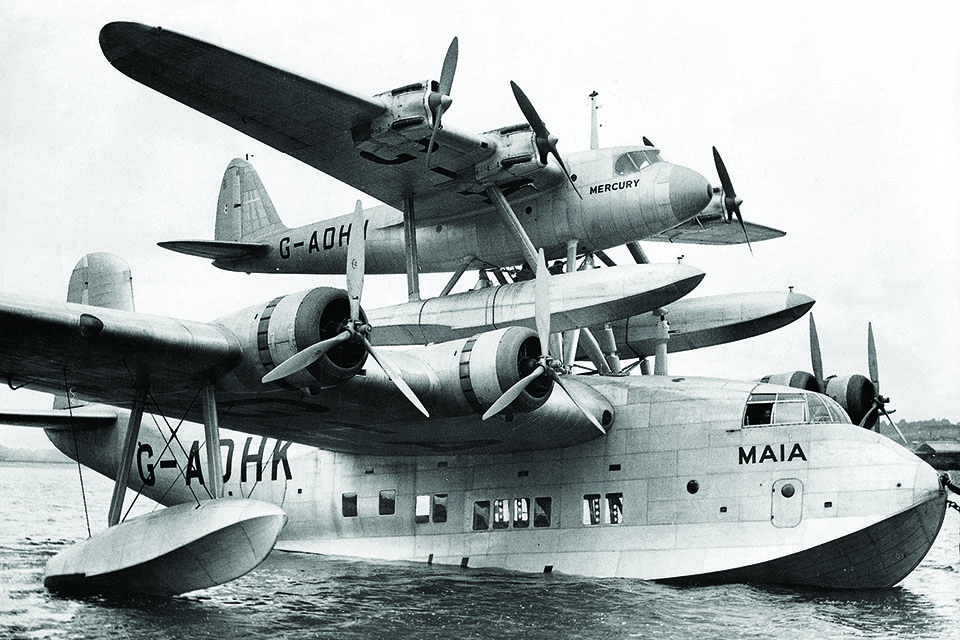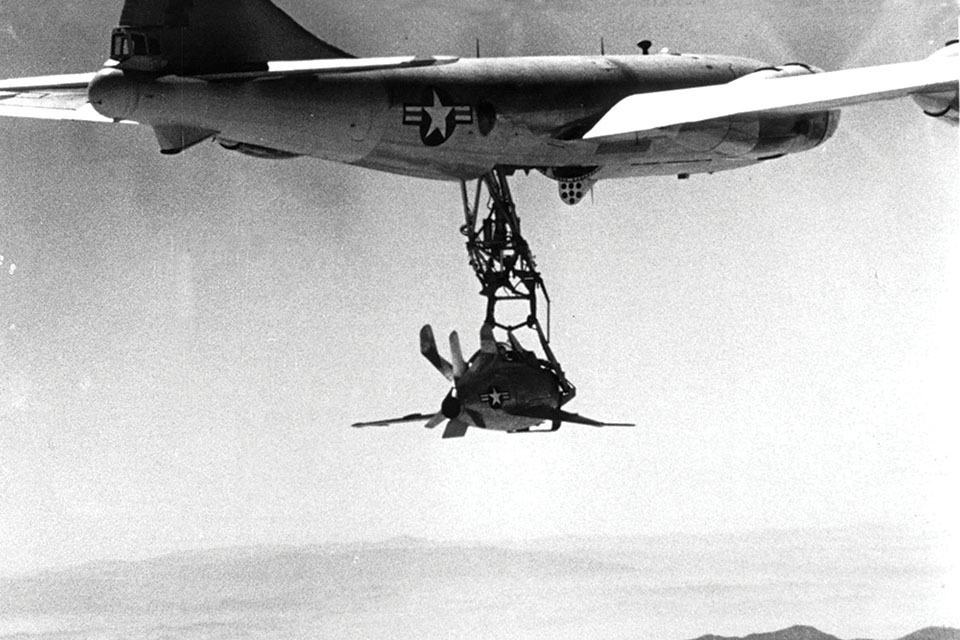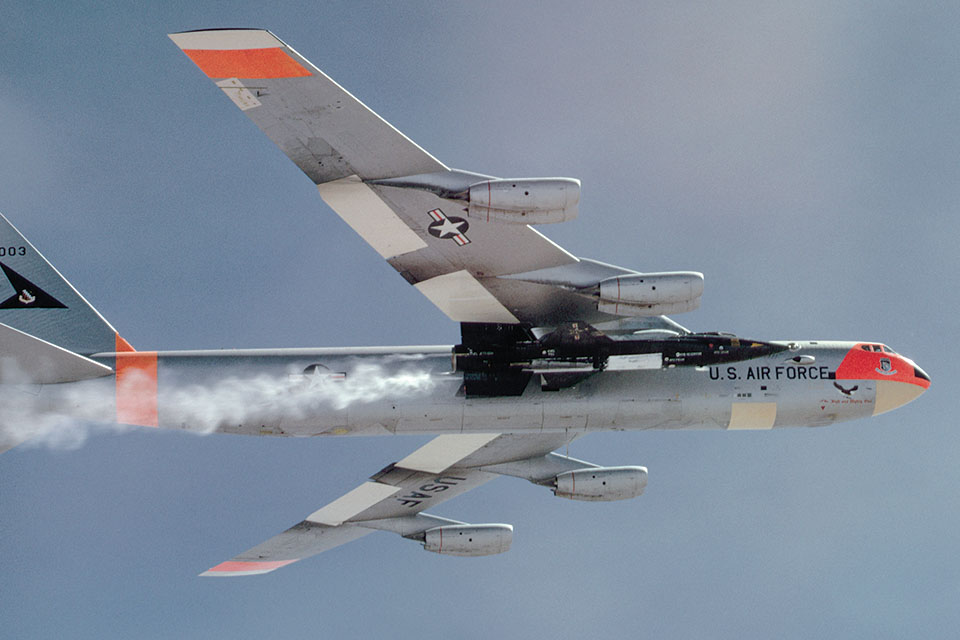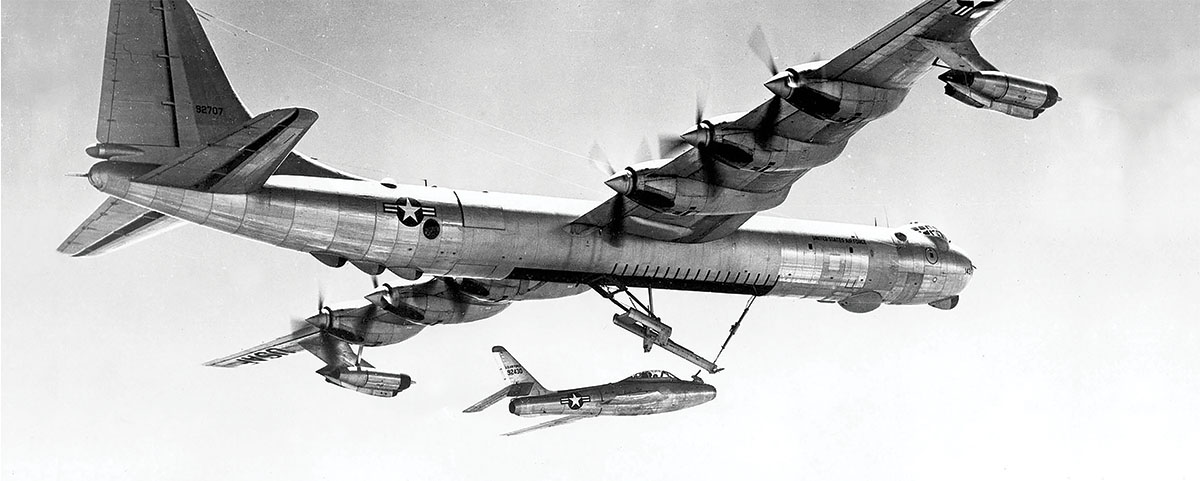Mother ships—aircraft designed to carry and launch small airplanes for specific missions—have existed for more than a century.
The concept dates at least to 1905, when pioneer glider designer John J. Montgomery employed balloons to lift his man-carrying gliders for release near San Jose, Calif.
Montgomery began studying problems of flight in the 1880s. He appreciated what would become a traditional airframe design, with aft-mounted tail surfaces deflected to affect pitch and yaw. He was also at the forefront of high-altitude flight.
While balloons had previously lifted parachutists, in March 1905 Montgomery used a hot air balloon to elevate his glider and aeronaut Dan Maloney to 4,000 feet at a time when other pioneer aviators were barely getting out of ground effect. This altitude assist allowed Maloney to maneuver and turn the glider into the wind and in any direction for unpowered flights lasting 15 minutes or more. The dangers of test flying manifested themselves chillingly on July 18, however, when a balloon rope tangled with the glider as Maloney was released over Santa Clara, sending him plummeting to his death.
In 1916 the British sought to give fighters the ability to reach German Zeppelins patrolling the North Sea, then out of fighter range. In likely the first use of one airplane to carry and launch another, a Bristol Scout was mounted to a Porte trimotor seaplane. On May 17, 1916, the aerial combination made a successful flight and separation, but the concept soon fell out of favor as experiments with aircraft-carrying naval vessels progressed.
After World War I, airship experiments with stowed biplanes expanded on wartime ideas. In October 1925, the British began conducting trials with a de Havilland D.H.53 mounted beneath the airship R33, successfully launching and recapturing the light monoplane that December. The following October, R33 carried and launched a pair of Gloster Glebe biplanes.
The U.S. Navy dirigible Los Angeles was the testbed mother ship for a trapeze arrangement that proved successful at capturing and releasing biplanes in 1929. By 1932, the Navy airship Akron served as a flying aircraft carrier, stowing Curtiss F9C Sparrowhawk biplanes in an internal hangar and lowering them for release. Akron’s sister airship, Macon, followed suit. F9C pilots soon mastered the mechanics of launches and recoveries via the airships’ trapeze mechanism. Akron also employed Consolidated N2Y two-seat trainers as couriers and to carry passengers to and from the dirigible.
Although the aircraft-carrying dirigible concept proved feasible, the unwieldy airships themselves were doomed: Both Akron and Macon were lost at sea before the end of the decade.

Seaplane mother ships resurfaced in England in 1938, when long-range mail-carrying aircraft could handily beat an ocean liner. The mother ship this time was a modified Short Empire-class S.21 flying boat named Maia. The airmail carrier was an unusual four-engine floatplane, the Short S.20 Mercury. Braced with struts, the smaller Mercury rode atop Maia and was otherwise unable to take off with sufficient fuel and payload to make a transoceanic flight. The Maia–Mercury combination performed its first separation on February 6, 1938, and operated scheduled airmail service from Southampton, England, to Alexandria, Egypt, until war broke out.
The Soviet Union also experimented with mother ship configurations under its Zveno (“chain link”) project during the 1930s. Various Zveno combinations typically relied on large Soviet bombers carrying two or more fighters for inflight release. As with other military mother ships, the purpose was to extend the range of fighters and provide immediate protection for bombers. Zveno proponents also argued that it would allow dive bombers to carry ordnance that otherwise would be too heavy for them to take off with conventionally. During the early stages of the German invasion in the summer of 1941, the Soviets used Zveno as many as 30 times to bomb bridges and other targets with two Polikarpov I-16 SPB dive bombers carried under the wings of Tupolev TB-3s. But in spite of a few successes, the Soviets abandoned Zveno by 1942.
World War II saw the Germans revive the piggyback airplane concept, initially with single-engine airplanes mounted above a troopcarrying DFS 230 glider. The Klemm Kl-35 monoplane could not lift itself and the DFS 230, so a Junkers Ju-52/3m towed the pair to altitude in September 1942. The test flight showed that the Klemm’s engine was insufficient to keep the duo aloft, though the two aircraft separated and made safe landings.
Next a Focke Wulf Fw-56 parasol monoplane with a 240-hp Argus engine was mounted atop the DFS 230. Although the Fw-56’s engine was still insufficient for an independent takeoff, the combination maintained altitude once aloft.
Tests with the DFS 230 continued with a Messerschmitt Me-109E fighter. On June 21, 1943, the Me-109E-propelled combination took off under its own power near Linz, Austria, landing, still mated, 40 minutes later.
The German piggyback glider combinations were dubbed Mistel (“mistletoe”), an apt use of a parasitic plant to describe parasitic aircraft. The Germans also used the term to describe their late-war efforts to mount a fighter atop an unmanned twin-engine Junkers Ju-88 laden with explosives. The fighter pilot guided the Ju-88 to its target, and then separated and returned to base. Mistel bombers generally failed to inflict serious damage.
Germany also embraced the Mistel arrangement as a means of lifting a reconnaissance aircraft to an altitude where a rocket motor could propel it above enemy interception. The ambitious mission profile called for a Dornier Do-217 twin-engine bomber to carry a dorsally mounted DFS 228 reconnaissance aircraft to 33,000 feet, where it would launch and ascend to 75,000 feet. Reconnaissance photographs would be captured at extreme high altitude in a shallow glide. The DFS 228 featured a pressurized capsule for the lone prone pilot, infrared cameras and a Walter bi-fuel rocket motor. While it only made gliding flights before war’s end, it demonstrated the Do-217’s utility as a mother ship.
At the end of WWII, France had access to much German equipment, including the Heinkel He-274 four-engine strategic bomber then under construction at Suresnes. Two He-274 airframes were completed as AAS-1s, and the French air force initially used them for high-altitude research before French industry flew them as mother ships, carrying test aircraft aloft on dorsal struts.

One of the most ambitious postwar mother ship efforts involved the McDonnell XF-85 Goblin parasite fighter. Anticipating the availability of super bombers such as the Convair B-36, and realizing early jet fighters lacked the range to escort them, the U.S. Army Air Forces sought to develop parasitic fighters to stow in the big bombers.
McDonnell responded with an unusual design for a jet-powered aircraft with a wingspan barely over 21 feet, swept 34 degrees. The wings folded to fit inside the bomb bay. A geometric puzzle of a tail performed its aerodynamic duties while being small enough to fit inside the mother ship. Perhaps most telling about the constraints the designers faced is the Goblin’s overall length: 14.8 feet.
The parasite had a pressurized cockpit with ejection seat. A large retractable hook in the nose engaged the mother ship’s trapeze. The Goblin’s Westinghouse J34 turbojet was expected to propel the egg-shaped fighter well over 500 knots, though that may have been optimistic.
The USAAF funded two XP-85 (later XF-85) prototypes, and because production B-36s were not yet available, a test B-29 Superfortress was modified with a trapeze to stow and release them. The tiny Goblin airframe had no provision for landing gear, so the parasite fighter’s mission profile consisted of an outbound ride in the mother ship’s bomb bay, aerial combat as needed and a ride back in the bomb bay.
The Goblin was supposed to be able to return to its mother ship to refuel and rearm twice during a mission. Five tons of equipment, fuel and supplies were to be stowed in the B-36 for its support. A declassified description of the XP-85 noted, “The physical limitations on a pilot are 5’ 8” and 200 lb weight with full equipment.”
Air Force planners figured one Goblin could be stowed in the no. 1 bomb bay of a B-36, leaving the second bay available for a bombload. Some B-36s in a group effort could carry three Goblins instead of bombs. Left unspoken was the fate of a Goblin whose bomber was shot down while the parasite was away.
The XF-85 prototypes had skids to allow emergency landings if testing went awry. And it did. On August 23, 1948, during the first flight of a Goblin, pilot Edwin Schoch barely avoided serious injury when the trapeze smashed his Plexiglas canopy as he tried to dock with the B-29. The skid enabled Schoch to recover safely on the dry lakebed below. A March 1949 flight damaged the trapeze during release, and the XF-85 made a safe skid landing on Rogers Dry Lake. Fewer than half of the handful of Goblin flights resulted in hook-ups and recoveries within the B-29. On April 8, 1949, during the final Goblin flight, the pilot attempted to engage the trapeze three times but had to make another lakebed landing.
If experienced test pilots encountered major difficulties docking with the mother ship, how would average operational pilots do it? Furthermore, the performance of the stubby Goblin would likely fall short in comparison to the conventional foreign jet fighters soon to be fielded. Thus in October 1949 the Air Force terminated the Goblin program
In another effort to carry a fighter in the B-36’s bomb bay, the Air Force compromised to allow a Republic F-84 or RF-84 to ride partially inside, with its wings and specially downward-canted elevators outside. Dubbed FICON, for Fighter Conveyor, the system attained limited operational use in the 1950s.
Given the hectic pace of Cold War aviation advancements, the need to carry a fighter for bomber defense diminished in the time between the first experiments with parasite fighters and the validation of the FICON concept. But high-altitude reconnaissance efforts might be well-served by FICON. Small and fast, the RF-84F (redesignated RF-84K for FICON) could dash into contested airspace and back out again, hitching a ride both ways in the belly of a B-36. And since the RF-84K was nuclear capable, it could conceivably have been used as the final sprinter in a relay delivery of a nuclear weapon on target.
By late 1955, Air Force FICON hook-ups were underway. The end of the FICON program the following year coincided with the winding down of B-36 operations in the last half of the 1950s and the introduction of the Lockheed U-2 reconnaissance aircraft.
Air Force experiments in the 1950s also saw F-84s hitch a ride wingtip-to-wingtip with a B-29 (Project Tip Tow) and a B-36 (Tom-Tom). The B-29 experiment ended in disaster when a connected F-84 flipped onto the mother ship and both aircraft crashed, with the loss of all on board. The B-36 range extender fell out of favor as traditional tankers gained traction and unaccompanied nuclear bomber missions became the norm.
Perhaps the best-known use of mother ships in the U.S. involved the X-plane series of rocket-propelled aircraft that required a lift to preserve their finite fuel for testing at altitude. Carried to launch altitude in the modified bomb bay of a B-29 on October 14, 1947, the Bell XS-1 became the first aircraft documented to surpass the speed of sound, attaining Mach 1.06.
Installing the X-1 in the B-29 required ingenuity. A steep ramp and loading pit were excavated at Muroc Air Force Base (today Edwards AFB) in California, and the X-1 was backed down the ramp. Then the B-29 was rolled over the pit until it was exactly lined up to receive the X-1 beneath it.
The X-1 was carried in the B-29 much like a large weapon, with a shackle and special sway braces to keep it from rolling from side to side. The rocket plane was exposed to the outside air through the B-29’s cutout bomb bay doors. An elevator allowed the pilot to access the X-1 in flight over the Mojave Desert.
Major (later Brig. Gen.) Robert Cardenas piloted the B-29 mother ship. “The X-1 was hoisted into place using the B-29 internal bomb hoist,” he recalled. “I could not lift the nose wheel of the B-29 more than about six inches [on takeoff] without scraping the X-1, which was not a good idea since it was loaded with propellant fuel.”
For its research flights, the National Advisory Committee for Aeronautics (NACA, NASA’s predecessor) converted a former Navy variant of the B-29, the P2B-1S, to carry the sweptwing Douglas D558-II Skyrocket. Instead of the ramp-and-pit method, NACA used huge hydraulic lifts to elevate the B-29 (and later B-50) mother ships high enough to permit the Skyrocket to be installed.
For the next level of X-plane testing—the hypersonic North American X-15—more capable carriers would be needed. The B-36, which offered better performance and load-carrying capability, was an obvious choice, but it was in its final years of service, and X-15 programmers worried about the ability to logistically support such a complex bomber once the fleet was retired.
The Boeing B-52 Stratofortress promised perhaps a mile higher launch altitude at faster speed than the B-36. Two early Stratofortresses were made available for the task: B-52A serial no. 52-003, nicknamed The High and The Mighty One, and RB-52B no. 52-008, generally referred to as Balls 8.
North American Aviation made the required modifications to the B-52s. The high-wing Stratofortress broke with mother ship tradition by carrying the X-15 on an underwing pylon inboard of the engines on the right wing rather than in the bomb bay. To accommodate the X-15’s vertical fin, a large angular cutout was needed in the trailing edge of the B-52’s wing.
No longer could the research pilot enter the test aircraft by climbing into its cockpit from inside the converted bomber. Now the pilot entered the X-15 as it hung from its pylon on the ramp, and he remained there throughout takeoff and ascent to launch altitude. A zero speed, zero altitude ejection seat for the X-15 boosted confidence in this new arrangement. The X-15 rode far enough ahead of the B-52’s wing to provide a clear overhead path for the pilot if he needed to eject while attached to the bomber.

In an early photoreconnaissance drone experiment, Lockheed’s celebrated Blackbird spyplanes were groomed to be mother ships for the Mach 3 D-21. Riding atop a modified A-12 Blackbird, the D-21 “stealth” drone carried a camera in a jettisonable package. After completing a sortie, the drone was to jettison the camera where it could be retrieved, and then self-destruct. Problems plagued the D-21 program, however, including a post-launch collision with the M-21 mother ship version of the A-12 that resulted in the death of one crewman. D-21s then shifted to B-52H mother ships, but subsequent tests, as well as unsuccessful missions over China between 1969 and 1971, failed to validate the concept. Improved satellite imagery and international politics contributed to cancellation of the D-21 program.
NASA used a pair of 747 jumbo jets for many years as space shuttle carrier aircraft. The first lifted the engine-less shuttle Enterprise high over Edwards AFB for approach and landing tests in 1977. With an angle-of-attack adjustment to the mounting struts, the 747 mother ships regularly ferried shuttles back to Kennedy Space Center after the reusable spacecraft landed at Edwards.
The Soviets built one example of the huge six-engine Antonov An-225 Mriya to carry the Buran space shuttle. When the Buran program was canceled in 1993, the An-225 went into hiatus, emerging years later as a conventional heavy-lift transport.
Orbital Science Corporation’s Lockheed L-1011 jetliner is another specialized mother ship, modified to launch a Pegasus rocket from ventral stowage. Dubbed Stargazer, the L-1011 has also been used for captive tests and transportation of Orbital’s X-34 hypersonic research plane (for drop tests, they used the B-52 Balls 8).
Burt Rutan’s Scaled Composites has built clean-sheet mother ships to carry its innovative spaceplanes to launch altitude. White Knight, powered by two afterburning J85 engines, was key to the success of launching SpaceShipOne into suborbital space in 2004—the first privately funded manned spaceflight. White Knight Two, dubbed Eve, is an all-new larger mother ship created to heft SpaceShipTwo in Richard Branson’s ongoing private space venture.
Today the mother ship concept continues to find new utility, with plans for aircraft to launch satellites into orbit and carry the next generation of drones. The goals remain the same: Give the hitchhiker the range and altitude to accomplish its mission.
Frederick A. Johnsen is the author of more than 20 books and numerous articles on aviation history. He served for many years as a U.S. Air Force historian, and was the curator for the McChord Air Museum at McChord AFB and director of the Air Force Flight Test Museum at Edwards AFB. This article has been adapted from his forthcoming book, Testbeds, Motherships and Parasites: Astonishing Aircraft From the Golden Age of Flight Test, due this January from Specialty Press.
This feature appeared in the January 2018 issue of Aviation History. Subscribe today!





